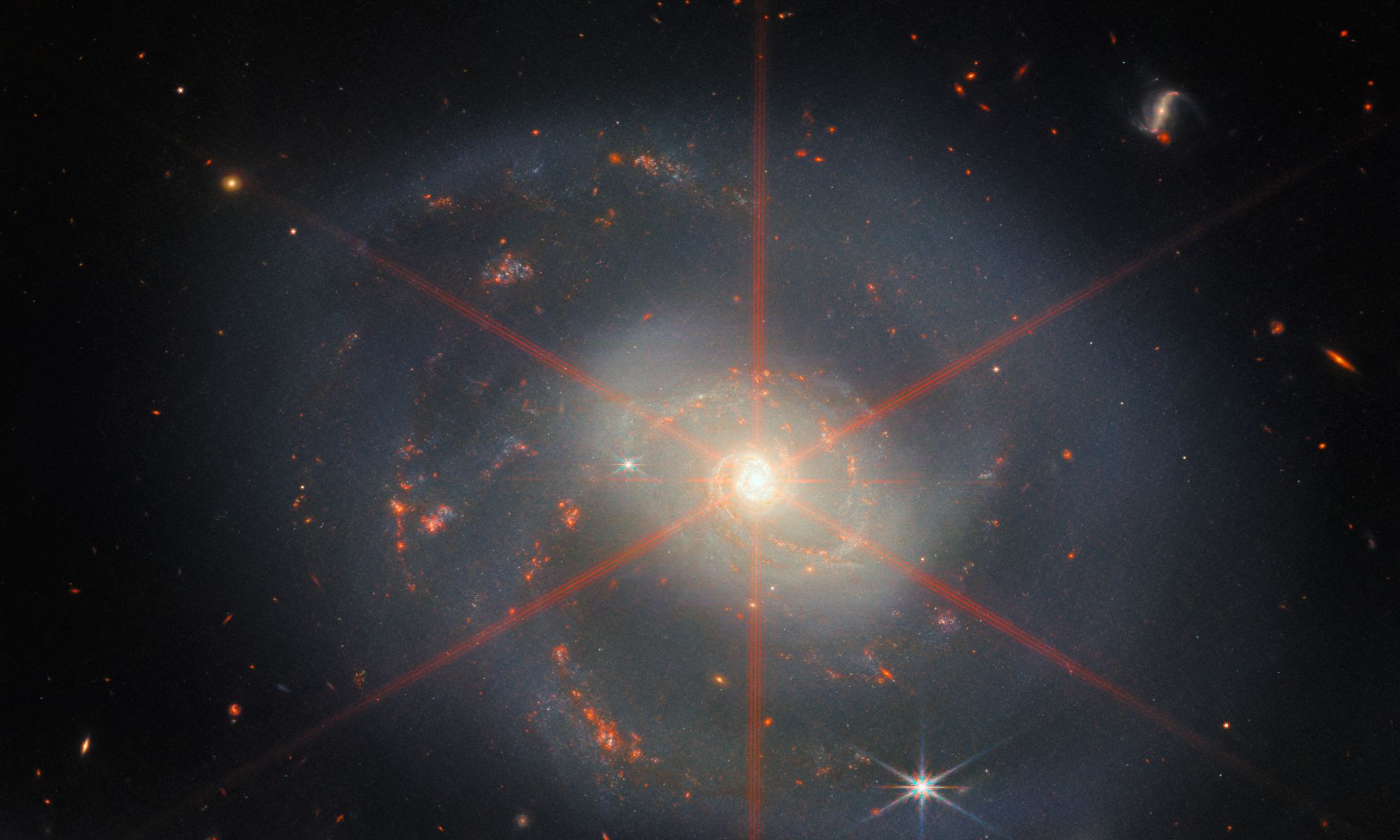When a spiral galaxy presents itself just right, observations reveal more detail. That’s the case with NGC 7469, a spiral galaxy about 220 million light-years away. It’s face-on towards us, and the James Webb Space Telescope captured its revealing scientific portrait.
NGC 7469 is scientifically interesting for a number of reasons and is the subject of several recent papers based on James Webb Space Telescope (JWST) observations.
It’s a luminous infrared galaxy (LIRG) with an active galactic nucleus (AGN.) It’s a Seyfert galaxy, which are some of the most intensely studied objects in the Universe. They’re similar to quasars but closer and less luminous. Astrophysicists think they’re powered by the same source as quasars, but they’re easier to observe. NGC 7469 has a bright nucleus and is one of the most studied galaxies of its type. It also has a starburst ring embedded in its circumnuclear region. To top all that off, it’s part of a pair of interacting galaxies, the other being the much smaller IC 5283. (The pair is also known as Arp 298 in the Atlas of Peculiar Galaxies.)
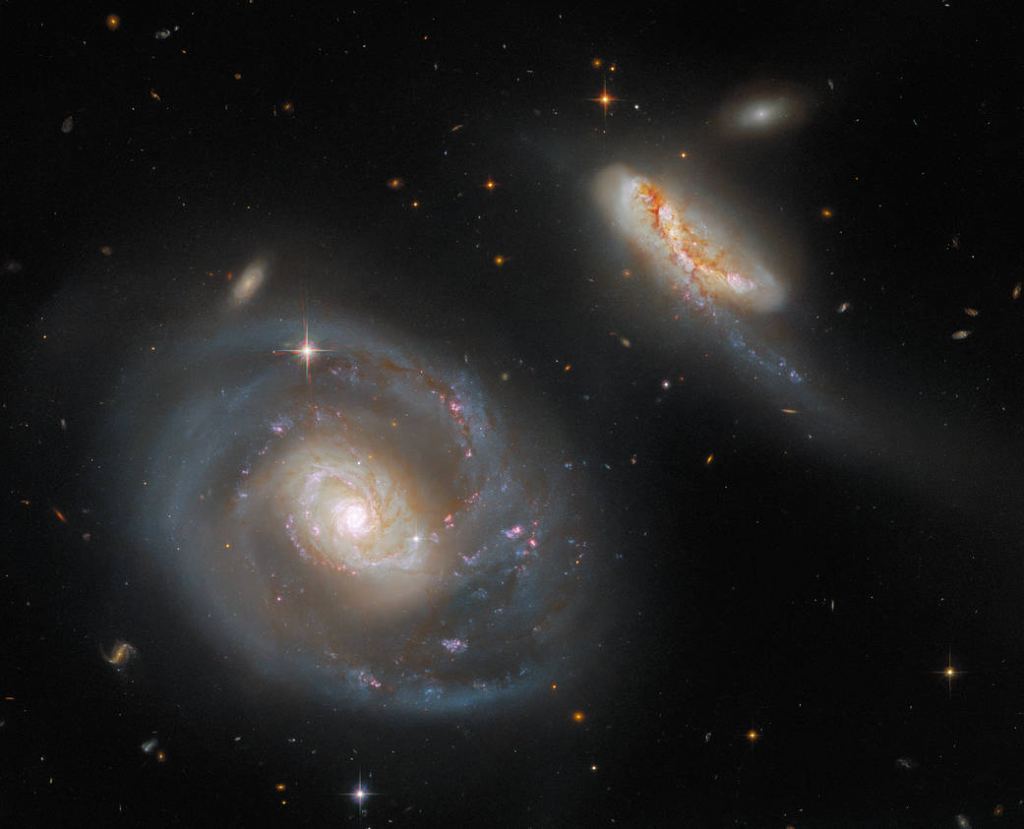
Because of all of its intriguing characteristics and because it appears face-on from our vantage point, astronomers have studied NGC 7469 intently. It only makes sense that once the JWST became operational, it would also cast its keen infrared eyes on the galaxy.
A recent observing program called GOALS (Great Observatories All-sky LIRG Survey) included the galaxy in its observations. GOALS combines observations of galaxies from multiple sources: Spitzer, Hubble, Chandra, GALEX, and now, the JWST.
The GOALS website says, “Galaxies evolve through a combination of secular processes, such as cold gas accretion, and non-secular processes, such as galactic mergers, which can trigger massive starbursts and powerful AGN. JWST will transform our understanding of galactic evolution, providing a detailed look at the physics of star formation and black hole growth in nearby and distant galaxies.”
While NGC 7469 is well-studied, its compact nature and its dust are both obstacles to understanding it. But the JWST’s power and sensitivity are overcoming those obstacles. The telescope is bringing new understanding to the relationships between the galaxy’s central AGN, the starburst ring, and all of the gas and dust.
The newly-released papers show how the JWST is transforming our understanding of galactic evolution. Its instruments—MIRI, NIRCam and NIRspec—have revealed new details hidden from the JWST’s predecessors. The GOALS team found very young star-forming clusters never seen before, as well as pockets of very warm, turbulent molecular gas. They also found direct evidence for the destruction of small dust grains within a few hundred light-years of the nucleus — proving that the AGN is impacting the surrounding interstellar medium.
The Webb also revealed more detail in the outflow of molecular gas coming from the galaxy. The gas is ionized and highly diffuse and leaves the galaxy at about 6.4 million kph (4 million mph.)
While the JWST has given us gorgeous images that inspire our spirit of wonder, the images in these studies are more scientific. You won’t see them on calendars, but they will appeal to your curious, inner astrophysicist.
The first of the papers is “GOALS-JWST: Resolving the Circumnuclear Gas Dynamics in NGC 7469 in the Mid-infrared.” It’s published in the Astrophysical Journal Letters, and the lead author is Vivian U, an Assistant Research Astronomer at the University of California Irvine.
This is the first time that mid-infrared gas dynamics in the central region of a LIRG nucleus have been seen so clearly. It’s another example of how the JWST’s power is pushing our understanding of galaxy evolution forward. The images clearly show how the AGN is depositing energy into the dense interstellar gas via shocks. It’s an example of AGN feedback, a subject of great interest to astrophysicists as they try to understand how that feedback shapes the growth and evolution of galaxies.
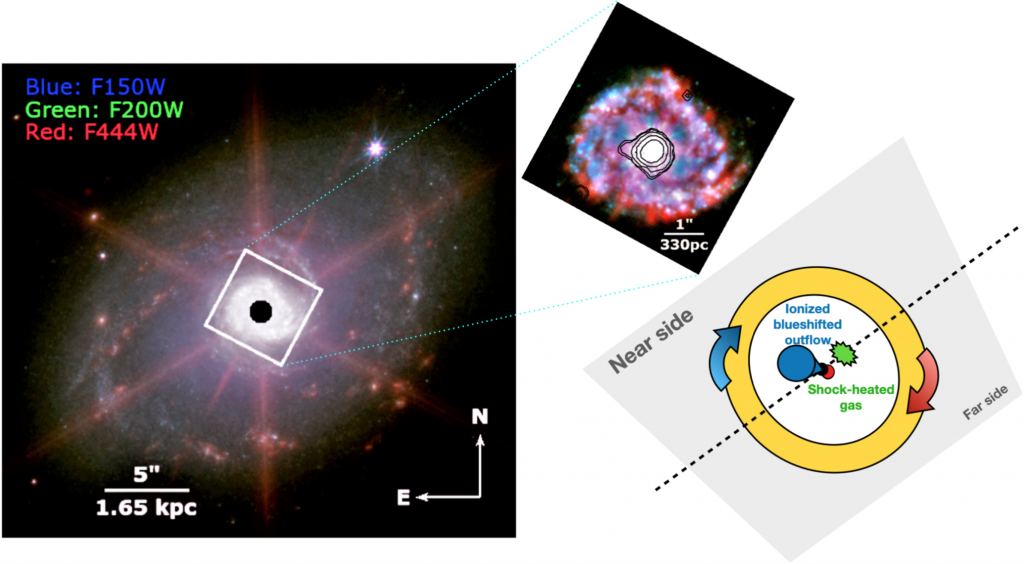
The second paper is “GOALS-JWST: NIRCam and MIRI Imaging of the Circumnuclear Starburst Ring in NGC 7469.” It’s been submitted to Astrophysical Journal Letters but is available at arxiv.org. The lead author is Thomas Bohn, from the Hiroshima Astrophysical Science Center, Hiroshima University, Japan.
This study identified 66 star-forming regions in NGC 7469’s starburst ring, 37 of which were not identified in previous Hubble Space Telescope observations. These are likely young stellar populations no older than 5 million years. This shows the JWST’s power to see through obscuring dust. “Thanks to JWST, we find a significant number of young dusty sources that were previously unseen due to dust extinction,” the authors write. “These results illustrate the effectiveness of JWST in identifying and characterizing previously hidden star formation in the densest star-forming environments around AGN.”
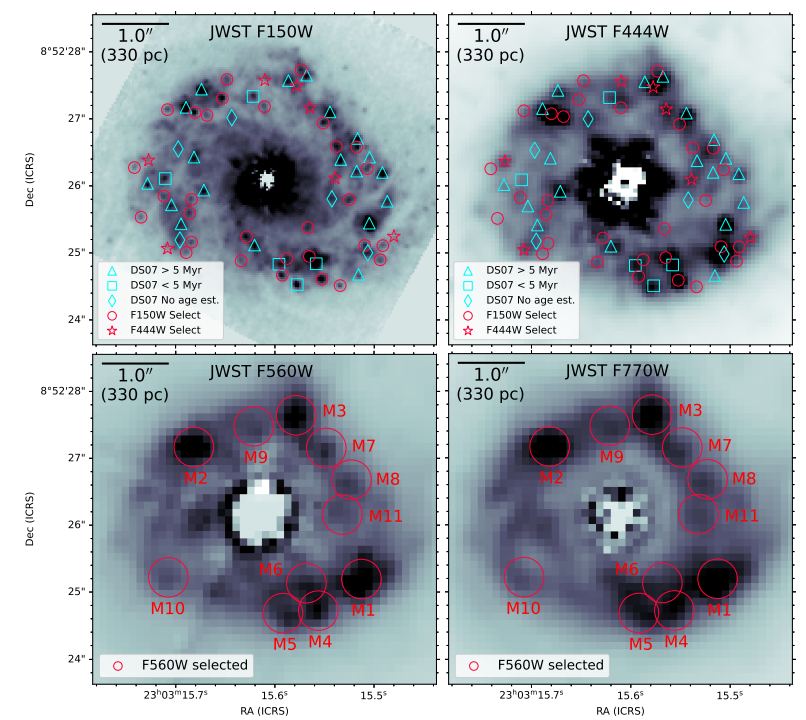
The newly identified regions in this study tend to be the reddest and faintest, according to the authors. That makes sense since the JWST excels at identifying those types of objects. The study results indicate that “… with JWST, we are discovering a large number of heavily obscured sources previously missed by HST.” That, in a nutshell, sums up the JWST’s purpose.
“In total, we detect 66 star-forming regions in NIRCam,” the authors explain.”This more than doubles the 30 sources previously identified by HST.”
The third study is “GOALS-JWST: Tracing AGN Feedback on the Star-Forming ISM in NGC 7469.” It’s available at arxiv.org. The lead author is Thomas S.-Y. Lai from IPAC, California Institute of Technology.
AGN feedback is a hot topic in astronomy. It explores how outflow gas from active galactic nuclei deposits energy and momentum into the interstellar medium (ISM.) AGN feedback plays a key role in the evolution of galaxies by redistributing gas. Somehow, SMBHs and their host galaxies co-evolve, and AGN is connected.
This study is focused on Polycyclic Aromatic Hydrocarbons (PAHs). PAHs are a large class of organic chemicals that all contain carbon atoms. They’re considered building blocks of life, but they also help astronomers in another way. They glow in star-forming regions and allow astronomers to trace the outlines of the clouds of gas that birth stars. PAHs can also indicate the star-formation rate.
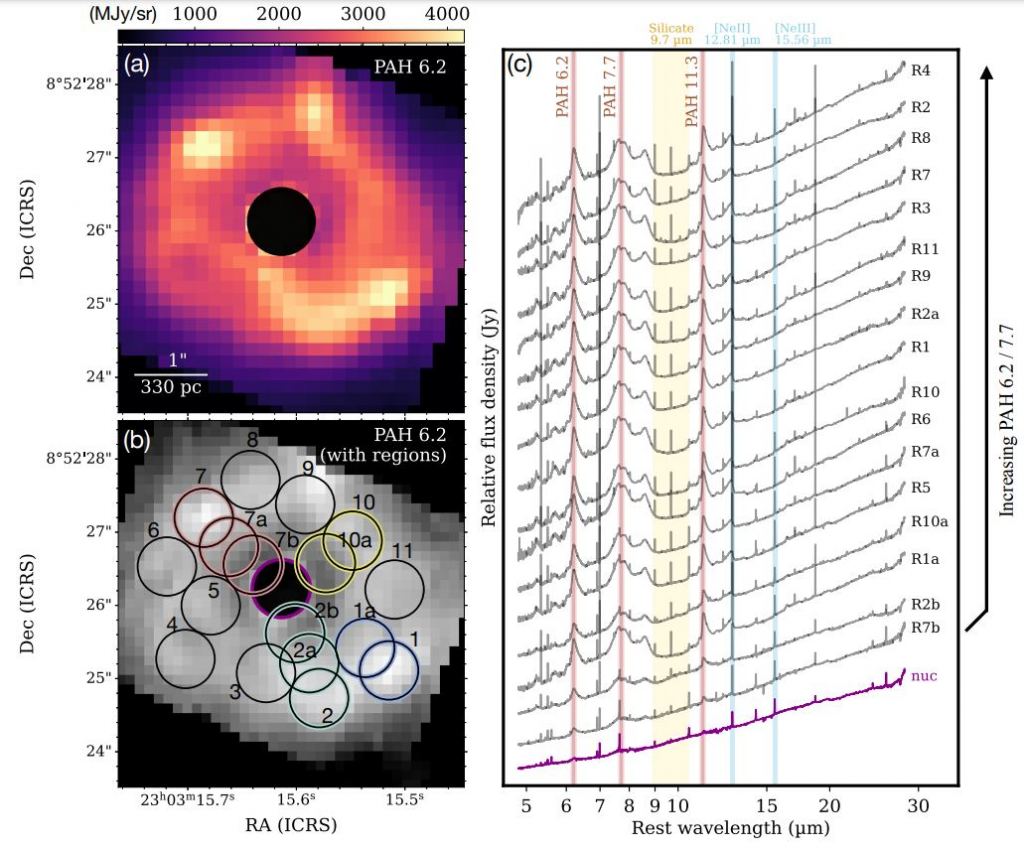
The characteristics of the PAHs in different star-forming regions shed light on AGN feedback in NGC 7469. The authors explain that “… the central AGN <has> only a moderate impact on the dust and gas properties throughout much of the starburst ring.” Their study also shows that there’s “… no clear sign of shocks from the outflowing wind heating the molecular gas.”
What does it all add up to? This data is too preliminary to arrive at any grand conclusions about AGN feedback. But it’s a piece of the puzzle that will help guide future observations. “Future observations with JWST will undoubtedly shed great light on the importance of feedback from AGN on star formation in galaxies,” the authors write.
The fourth paper is “GOALS-JWST: Mid-Infrared Spectroscopy of the Nucleus of NGC 7469,” and it’s been submitted to Astrophysical Journal Letters. It’s also available at arxiv.org. The lead author is Lee Armus from IPAC, California Institute of Technology. It focuses on the outflow from NGC 7469’s Active Galactic Nuclei.
The authors point out how critical LIRGs are in understanding black hole growth. Massive bursts of star formation power most of LIRGs luminosity, but the AGNs also contribute. AGN contributions to the galaxies’ luminosity vary widely, and that’s something astrophysicists want to understand better.
Previous infrared observatories like the Spitzer Space Telescope were helpful, but Spitzer was limited by its small mirror. Once again, the JWST is pushing the boundaries of infrared observations. Its larger mirror and higher sensitivity are paying dividends. “… we are now poised to greatly extend our understanding of dusty star-forming regions, nascent AGN, galactic outflows, and all variety of active galaxies over an extremely large stretch of cosmic time,” the authors write.
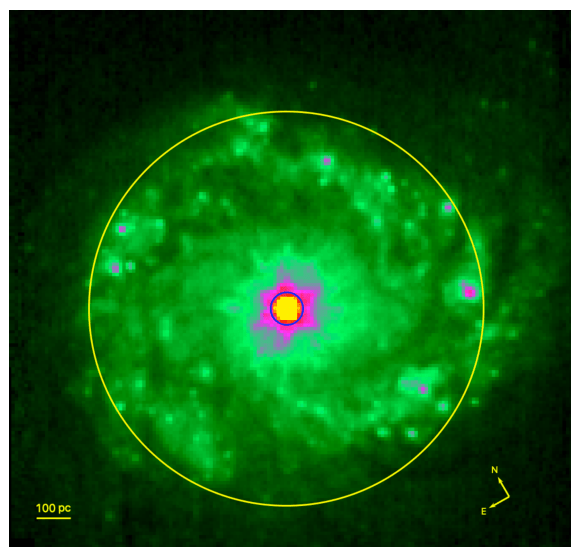
The region around AGNs is complex and multilayered. The authors of this paper call it a “… multi-phase
interstellar media surrounding actively accreting supermassive black holes,” and they mention how these MIRI images, though early, highlight the JWST’s powerful ability to explore the region.
Compared to earlier IR observatories, the JWST’s “… greatly increased resolving power allows the shapes of the midinfrared lines and hence the dynamics of the atomic and warm molecular gas, to be analyzed in detail for the first time.” One of their findings is that gas in the AGN’s nuclear wind is blue-shifted and moving much faster than thought. Perhaps counterintuitively, the mostly blue-shifted gas suggests that NGC 7469’s AGN-driven outflow is decelerating. That shows how complex the region is and why detailed observations with the JWST are the best way forward in understanding galaxies, star formation, and black hole growth.
While the Webb’s gorgeous images of structures like the Cosmic Cliffs create headlines and fuel our imaginations, these studies show how its resolving power and sensitivity are driving science forward.
The leading image of NGC 7469 is the Webb’s picture of the month for good reason. The galaxy’s spiral arms, its bright nucleus, and even the diffraction spike from the telescope itself are all important ingredients in a tasty image.
But as these four early paper show, the JWST is delivering a wealth of data alongside its more accessible images. With a $10 billion+ price tag, that’s really what the telescope is all about.
More:
- Press Release: A wreath of star formation
- GOALS: JWST Papers
- Universe Today: Webb Sees Organic Molecules in the Hearts of Galaxies, Surprisingly Close to Active Supermassive Black Holes

